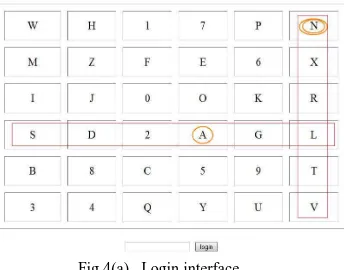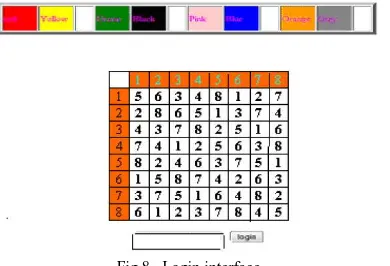images labeled by blue rectangles are in identical order with that in original image.
A hidden story may be “a couple and the son want to share a cake at their house”. To log in, a user should draw a curve to orderly cross the pass-images from the given head image to the tail image.
The new shape based textual authentication scheme consists of three steps:
• password creation • password entry • password verification
The design and analysis of graphical passwords by Jermyn, et al. [7] proposed a new technique called “Draw- a-Secret” (DAS) as shown in figure 2 where the user is required to re-draw the pre-defined picture
on a 2D grid. If the drawing touches the same grids in the same sequence, then the user is authenticated. This authentication scheme is vulnerable to shoulder surfing.
A User Identification System Using Signature Written with Mouse by Syukri [8] developed a technique where authentication is done by drawing user signature using a mouse as shown in figure 3. This technique included two stages, registration and verification. At the time of registration stage the user draws his signature with a mouse, after that the system extracts the signature area. In the verification stage it takes the user signature as input and does the normalization and then extracts the parameters of the signature. The disadvantage of this technique is the
forgery of signatures. Drawing with mouse is not familiar to many people, it is difficult to draw the signature in the same perimeters at the time of registration.
Fig 1. Graphical interface during the password creation.
Fig 2. DAS technique by Jermyn
3. SYSTEM ARCHITECTURE
Authentication technique consists of 3 phases: (1) Registration phase
(2) Login phase (3) Verification phase.
During registration, user enters his password in first method or rates the colors in the second method. During login phase, the user has to enter the password based on the interface displayed on the screen. The system verifies the password entered by comparing with content of the password generated during registration.
3.1 Pair-based Authentication scheme:
During registration user submits his password. Minimum length of the password is 8 and it can be
called as secret pass. The secret pass should contain even number of characters. Session Passwords are generated based on this secret pass. During the login phase, when the user enters his username an interface consisting of a grid is displayed. The grid is of size 6 x 6 and it consists of alphabets and numbers. These
are randomly placed on the grid and the interface changes every time.
Figure 4(a) shows the login interface. User has to enter the password depending upon the secret pass. User has to consider his secret pass in terms of pairs. The session password consists of alphabets and digits. The first letter in the pair is used to select the row and the second letter is used to select the column. The intersection letter is part of the session password. This is repeated for all pairs of secret pass. Fig 4(b) shows that L is the intersection symbol for the pair “AN”. The password entered by the user is verified by the server to authenticate the user. If the password is correct, the user is allowed to enter in to the system. The grid size can be increased to include special characters in the password.
3.2 Gridding based Authentication Scheme
At the time of registration the user enter the image. Then select grid value and apply on the image. The image is now converted into gridding format having 3 x 3 grids. Means 9 grid images are get from original image as shown in figure 5(a) and 5(b).
Fig 4(a). Login interface Fig 4 (b). Intersection letter for the pair AN
The user select grid patterns as per their views. When enter in login phase then the original grid image is now converted into 5 X 5 grids. Means total 25 grid images are formed. Then user select appropriate grid block of image as shown in figure 6, as he enter in registration phase. Also maintain the sequence of grids.
3.3 Hybrid Textual Authentication Scheme
During registration, user should rate colors as shown in figure 7. The User should rate colors from 1 to 8 and he can remember it as “RLYOBGIP”. Same rating can be given to different colors. During the login phase, when the user enters his username an interface is displayed based on the colors selected by the user. The login interface consists of grid of size 8×8. This grid contains digits 1-8 placed randomly in
grid cells. The interface also contains strips of colors as shown in figure 8. The color grid consists of 4 pairs of colors. Each pair of color represents the row
and the column of the grid.
Figure 8 shows the login interface having the color grid and number grid of 8 x 8 having numbers 1 to 8 randomly placed in the grid. Depending on the ratings given to colors, we get the session password.
As discussed above, the first color of every pair in color grid represents row and second represents
column of the number grid. The number in the intersection of the row and column of the grid is part of the session password. Consider the figure 8 ratings and figure 8 login interfaces for demonstration. The first pair has red and yellow colors. The red color rating is 1 and yellow color rating is 3. So the first letter of session password is 1st row and 3rd column intersecting element i.e 3. The same method is followed for other pairs of colors. For figure 9 the password is “3573”. Instead of digits, alphabets can be used. For every login, both the number grid and
the color grid get randomizes so the session password changes for every session.
Fig 6. 16 extra grids added to the original grid image and make 5 X 5 grids
Fig 7. Rating of colors by the user


